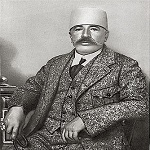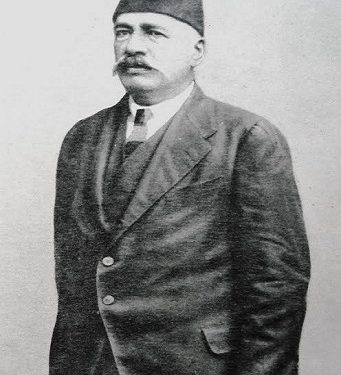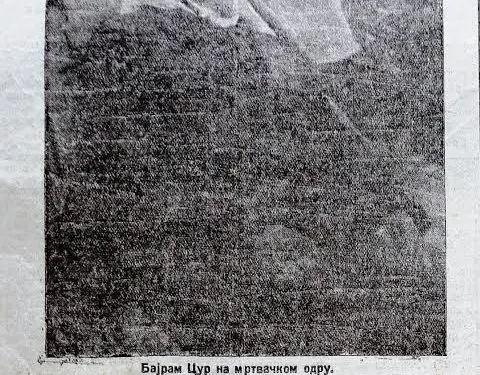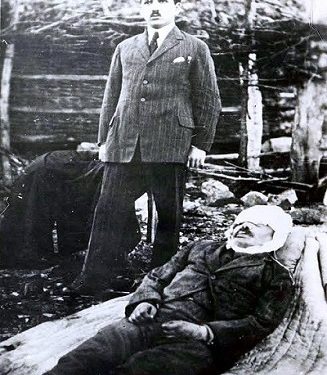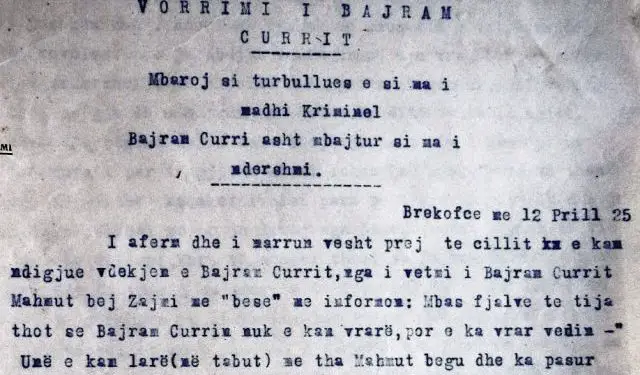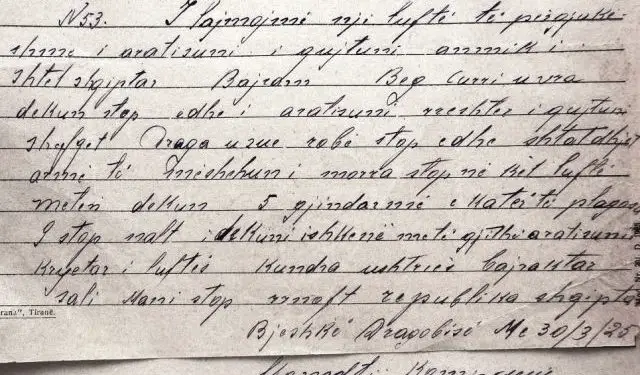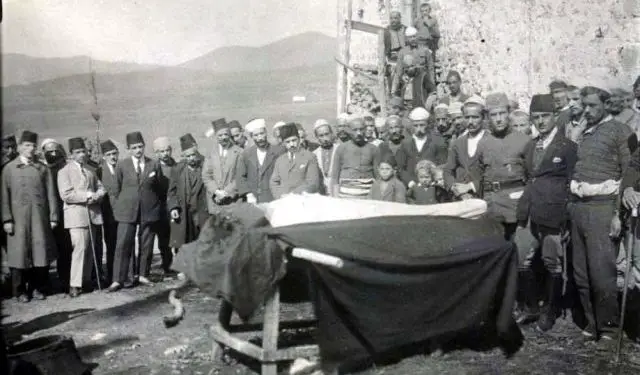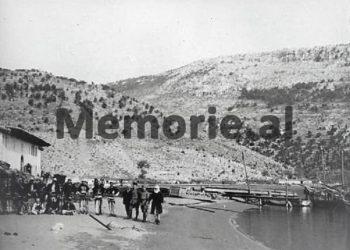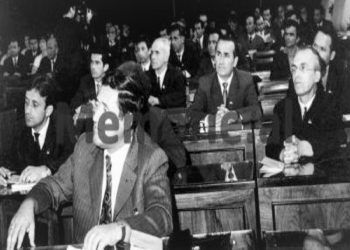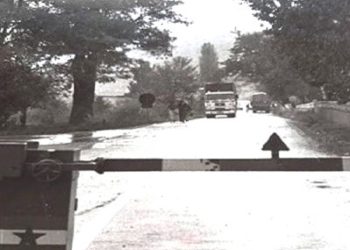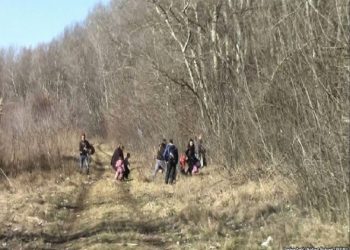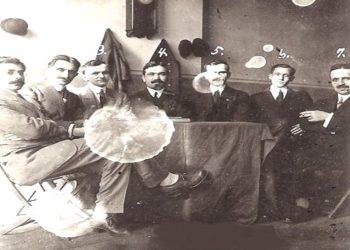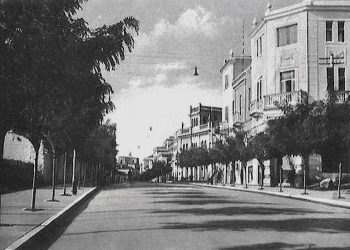From Veli Haklaj
– “Politika” newspaper of Belgrade: “Before he killed me, Bajram Curri told his henchmen; I am dying with honor, and if I had wanted to surrender to anyone, I would have surrendered only to Serbia, but I didn’t sell you money”-
Memorie.al / Originating from the well-known tribe of Krasniqe (Gjakova Highlands), born in Gjakova, Bajram Curri became an activist of the national movement of the Renaissance period, being one of the political and military leaders of the anti-Ottoman popular uprisings and of the struggle for the liberation and national unification of the country. He was one of the organizers of the Albanian League of Peja (1899-1900) and its activist, for the autonomy of Albania and for the protection of the territorial integrity of the country; main leaders in the anti-Ottoman uprisings in the period 1908-1912, which were finalized with the declaration of independence. After 1912, he fought in Kosovo, for its protection from the Serbian invaders. It did not agree with the decisions of the London Conference of 1913, which separated Kosovo and other eastern and southern Albanian territories from the independent Albanian state. In 1918, he was elected a member of the “National Defense of Kosovo” Committee and was one of its main leaders.
Bajram Curri in the Albanian National Movement
In a portrayal of Bajram Curri, Father Zef Valentini would highlight: “Bajram had a chance, we reminded him of his gender name, Curraj, and they told him: I am Curr!” In the spiritual building of the Shqipnis, the foundations will be laid of curras, of characteristic virtues of the tribe; when these stay, even Albania has; when these are removed, Shqipnis will be played “carani i votra”.
Contributions to the consolidation of the Albanian State
At the Congress of Lushnja, Bajram Curri was elected a member of the National Council, which appointed him minister without portfolio, in the government of Sulejman Delvina. In the years 1920-1921, in the capacity of Operation Commander, he collaborated with the Minister of the Interior, Ahmet Zogu, to realize the establishment of the authority of the Albanian state, in the entire territory of Albania recognized by the London Conference in 1913. By decree no. 846, dated May 30, 1920, of the Council of Ministers, Bajram Curri was appointed commander of the Operation, against the Movement of Central Albania; on June 30, 1921, Bajram Curri was appointed commander of the Operation, against the movement of Marka Gjon in Mirdita.
Armed action against the institutions of the Albanian State
Conflicting political developments, where armed movements were not missing, positioned Ahmet Zogun and Bajram Currin in opposite camps. Oral tradition also shows the marriage of Ceno Beg Kryeziu with Ahmet Zogu’s sister as the cause of their cooling; the Curri and Kryeziu families had inherited a history of conflicts between them. From March 1922, Bajram Curri chose the path of armed action against the Albanian state institutions. He was one of the main protagonists in the movement of 1923 and in the June Revolution of 1924. After the Triumph of Legality (December 24, 1924), he retreated to Krasniqe, staying as a friend of Krasniqe’s bajraktar, Sali Mani, from where he continued his efforts desperate for the organization of a new movement against the legitimate government in Tirana.
The suicide of Bajram Curri
On January 2, 1925, Bajram Curri gathered the Krasniqe council and the day after, Krasniqe’s allegiance was declared, in order to oppose any government teaching. On January 8, around dawn, Curri’s forces from Krasniqja capture Gashi, and after a fight in which 10 were killed and one wounded by government forces and one killed and one wounded by Curri’s supporters, Bajram Curri takes only Tropoja, the center of Gashi. On January 9, Curri’s force from Tropoja left for Bytyç, aiming at Kruma, the center of the Kosovo Prefecture, where other forces from Krasniqja had started, thus presenting a serious threat to the stability of the state.
In order to extinguish this new rebellion in the North of Albania, the President of the Republic, Ahmet Zogu, in the capacity of Prime Minister and Minister of Internal Affairs, had appointed Ceno Beg Kryeziu, Operation Commander for the North. Meanwhile, Ceno’s brother, Hasan Kryeziu, served as the prefect of Kosovo (Kukës, Has, Tropojë). In the conditions that the situation was getting worse by the hour, evaluating the potential of Bajram Curri, for armed movements, with the reserve telegram, no. 19, dated January 8, 1925, the Northern Operation Command is ordered, that; “The strictest and definitive measures should be used against Bajram Curri, so that there is no need for operations in those places…”.
A day later, on January 9, another urgent telegram was sent to Ceno Beg, by Prime Minister Ahmet Zogu, with the order: “Currin alive or dead, you must seize his power, you must destroy him completely, take all the measures that so that the Kosovo revolution is extinguished, so that it does not happen again”. Surrounded by gendarmerie forces and with no hope of rescue, Bajram Curri killed himself on March 29, 1925, in a cave in Gryka e Dragobia (Tropojë).
On March 30, 1925, from the mountains of Dragobia, the commander of the gendarmerie company that carried out the operation, Lieutenant Kadri Malësia (Mustafa), telegraphed Tirana: “We inform you that in a bloody war, you escaped, you were called an enemy of the Albanian state, Bajram Beg Curri, was killed and escaped Shefqet Draga, was taken prisoner. Seventy hidden guns too, I got them. In this war, 5 soldiers were killed and 4 wounded. Nalt i dekuni, ex have with all the fugitives. The leader of the war against the army (was) Bajraktar Sali Mani. Long live the Albanian Republic”!
On March 31, the Ministry of the Interior telegraphed the prefectures, sub-prefectures, and central and local newspapers informing them of the event. At the end of the telegram, it was stated: “… Since Bajram Curri has always played with the fate of the Kosovo Highlands, his disappearance in this way will ensure the happiness and rest of the people of that region”. On April 1, 1925, the Deputy Minister of Internal Affairs, Kostaq Kotta, sent this telegram of thanks to the Prefecture of Kosovo, which was forwarded to the Press Office for publication: “This minister considers it a moral duty to thank you for your care and the activity you showed in the murder of Bajram Curri, and I pray for success whenever you are in charge of the head of that Prefecture, Mr. Hasan Kryeziu”.
On April 1, 1925, in appreciation of the contribution to the establishment of order in the North of Albania, the President of the Republic, Ahmet Zogu, appointed Ceno Beg Kryeziu, Minister of Internal Affairs. For this, congratulatory telegrams came to him from all the prefectures and sub-prefectures, as well as from the people, where their warm congratulations and joys were shown. Based on the content of these telegrams, the newspaper of the time; “New Albania” (Constanța, Romania) evidences that; “The people of Albania seem very satisfied with the appointment of Mr. Ceno Kryeziu, as Minister of P. Interior”.
The murder of Bajram Curri in the pages of the newspaper “Politika”
The murder of Bajram Curri echoed in non-Albanian newspapers, especially in neighboring countries. In number 6096, dated April 13, 1925, the Belgrade newspaper “Politika” publishes this description of the murder of Bajram Curri:
The celebration of Bajram Curri
I end up as a troublemaker and, like the biggest criminal
Bajram Curri, you are considered the most honest
Brekofc, on April 12, 1925.
My relative and I heard from whom, I heard the death of Bajram Curri, from the only one of Bajram Curri, Mahmut bey Zajmi with “trust”, informs me: According to his words, he says that “Bajram Currin. They didn’t kill him, but he killed the vedi”. – I washed it (in the coffin), Mahmut Beg told me, and there were men’s clothes. He confessed everything to me, so I asked him. He says: – Until the last ten minutes, I was in the middle of the war with Bajram Curri, thirty full years. Mahmut bey Zajmi tells me:
– When Ahmet Beg arrived in Tirana, Bajram Curri neither wanted to run nor surrender. He knew Albanians and Albanians and believed that Ahmet Bey would not stay in power for long. He took with him people, many villages and many places. You hid in Çerem, Guci; once he also went to Montenegro, in order to surrender to them, but he still repented. Then I return to Mal i Šala, to the first of the Catholics, where he spent most of his time. Then he went to Dragobi, but a month ago, he went to Krasniq. Then he was investigated and he and 28 others went to a cave not far from the town of Kerstenič (Krasniq). He lived 27 days in that cave.
His people left him alone out of fear. With him, the brother of Ferhat bey Draga, Shefqet bey Draga remains. They have been in a difficult condition from the great winter, so that all of them have lost a leg (frozen) from the great cold, and the burning of the legs is so great that they have no months to wait. the legs. When the gendarmerie had surrounded the cave where they were, Bajram Curri immediately put on his rifle and fired 37 bullets with his Mauser, then he took out his revolver and held it to his head, and he was killed. After two hours, the gendarmerie entered the cave and found him dead. Shefqet Begu was alive and buried in Krumë (center of Kosovo Prefecture). Two days, the hall lasted.
For us Albanians, the hall is a sign of misery. There I asked my relatives about everything, because I was “in the blood”. They told me that he, all the kachaks, started them before he killed the vedi and they said: “Go, because I am releasing you from the faith, because it is a sin for young people like you to be killed. When you go, say that Bajram Curri, he would rather die with honor than surrender. I wanted to hand you over to someone, I had only handed you over to Serbia, but I didn’t want to sell you for money”. We buried him in Kruma, at the largest Mosque, with the greatest honors, where friends, authorities and the army were presented.
This is how Mahmut bey Zajmi finished his speech. After the questions I asked, and the answers I received from my friend, I have heard these things about Bajram Currin before. As we joined in his burial, there were a couple of thousand people, unfortunately, among these countries, they are known for many. These were the delegates of all provinces: Malet e Gashi, Krasniqe, Nikaj and Mertur. And the biggest surprise, that all the representatives of the authorities, both soldiers and civilians, were there. A group of soldiers, as a sign of respect, emptied their rifles when Bajram Currin was released.
Hasan bey Kryeziu, Prefect of Kruma, in his speech, among other things, said the following: “Today Baba i Shqipnis was killed. The friend is feeling the same, why are we honoring him like this. Although his body is finished, his Spirit will forever remain among them. …He follows Albania, like a small child’s nana, and fought for its growth…”. The representative of the Government, I finish his speech like this: “Cry, O people, for the Father of Shqinia”.
It was noticeable that at his funeral, there were many Catholics from Northern Albania. After the Prefect, Kadia i Kruma took the floor and at the end, an active captain of the Albanian Gendarmerie took the floor. I characterize these words of the deceased Bajram Curri: “… Listen, Kosovars and Dukagjinans! Today we are burying the freedom of our Kosovo”! In this way, that barbarian, Bajram Curri, was buried, who always tried to collect his own mistakes, and you promoted them in the same way, as he took them from others. Why with this way, since the Albanian Government has given him importance and honor, for his burial, we will find out in a little while. Memorie.al
B.G.
Translated, April 22, 1925
(signature illegible)




